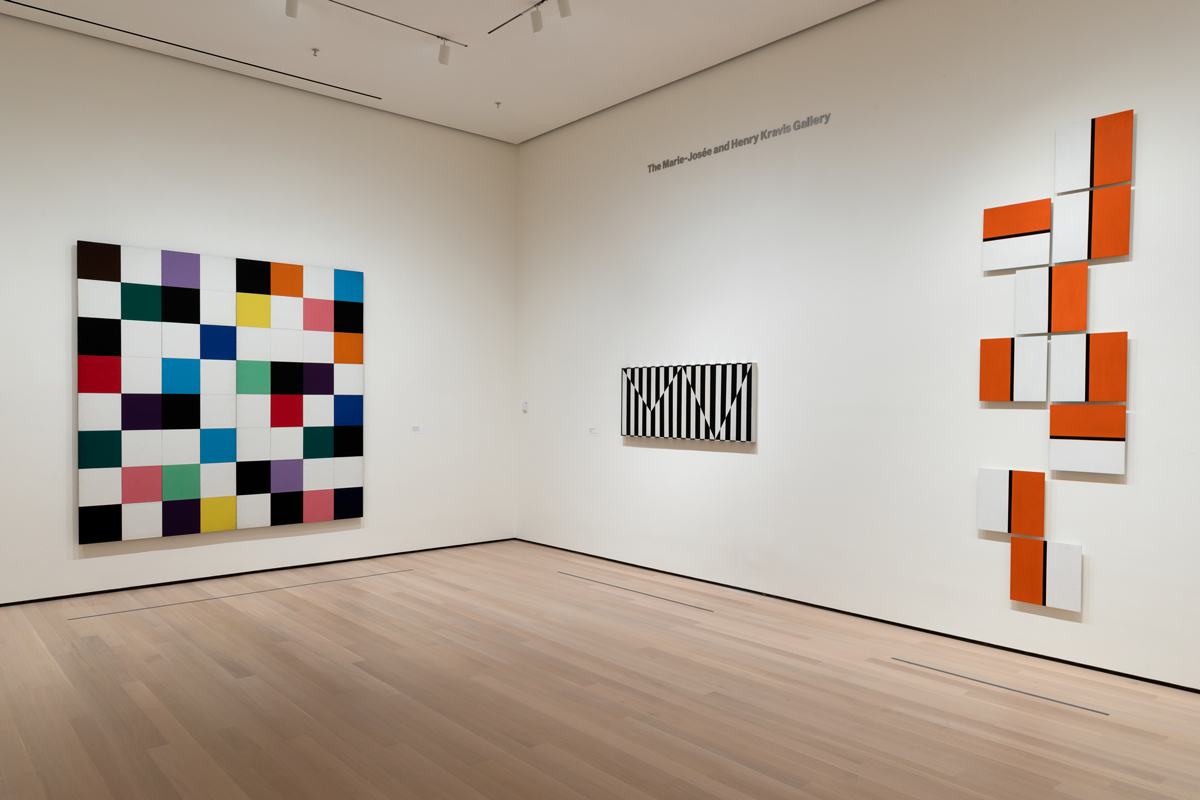[ad_1]

Installation view of the Museum of Modern Art’s reopening collection rehang, showing work by, from left, Ellsworth Kelly, Carmen Herrera, and Lygia Pape in a gallery titled “In and Out of Paris.”
ROBERT GERHARDT/©2019 THE MUSEUM OF MODERN ART
Olga Viso is a fellow in residence at the Andrew W. Mellon Foundation and a past director of the Walker Art Center in Minneapolis and the Hirshhorn Museum and Sculpture Garden in Washington, D.C. She is also the senior adviser for global partnerships in the arts at Arizona State University’s Herberger Institute for Design and the Arts, where she oversees a partnership with James Turrell’s Roden Crater. She has worked as a curator at institutions including the Norton Museum of Art, the High Museum of Art, and more.
The reinvention of the modern art museum has been the aspiration of many in the profession for decades. But while fleeting moments of re-imagination and rupture have occurred since the advent of postmodernism in the late 1970s and the multicultural ’80s, a consistent and sustained undoing of the museum setting has yet to be realized or even substantially modeled—at least, maybe, until now at the new MoMA.
The dismantling of the Eurocentric tradition of modernism is, for the most part, established in academia, where it has been championed by postmodern and postcolonial scholars in fields focused on intersectional understandings of history related to race, ethnicity, and gender. And “institutional critique” has long had currency among artists, who have found ways to work both inside and outside formal museum walls.
But save for a few exceptions—Fred Wilson’s prescient “Mining the Museum,” organized by the Contemporary in Baltimore for the Maryland Historical Society in 1992; acknowledgement of “alternative modernisms” and changes in collecting habits that same decade at the Walker Art Center (where I was later executive director, starting in 2007); Tate Modern’s 2000s-era expansion of the canon to consider Latin America, Africa, Asia, and the Middle East as well as women and people of color—dramatic change in the paradigm of museum practice has proven elusive.
Signs of all the above are evident in the newly re-opened MoMA. Yet its tabula rasa marks an even bigger breakthrough of a different order and potential magnitude. Its promise is simple: a commitment to sustained expression and iterative re-expression that can adapt and take on different forms in time.
Nothing is to be “permanent” or fixed at the new MoMA, marking a return to the institution’s founding imperatives. History is fluid and ever-changing and open to perpetual reconsideration. In practice, change will arrive through a continual process of editing and frequent rotation (significant rehangs are forecast twice a year), and in this scenario, nothing can be seen as too precious—save, perhaps, for the 10 or so works that visitors will always demand to be on constant view, like Monet’s Water Lilies (1914–26), Van Gogh’s Starry Night (1884), and Picasso’s Les Desmoiselles d’Avignon (1907).
Yet even such icons are expected to shift placement and context over time, inspiring new narratives that recalibrate our understanding of venerated monuments in art. The dynamic duet between Faith Ringgold’s American People Series #20: Die (1967) and Picasso’s Desmoiselles has been touted as a banner coupling of works that wouldn’t have shared such proximity before. Yet other exemplars abound on the museum’s fourth and fifth floors, where curatorial interjections offer a nuanced historical reshuffling that surfaces new actors without diminishing the unimpeachable icons.
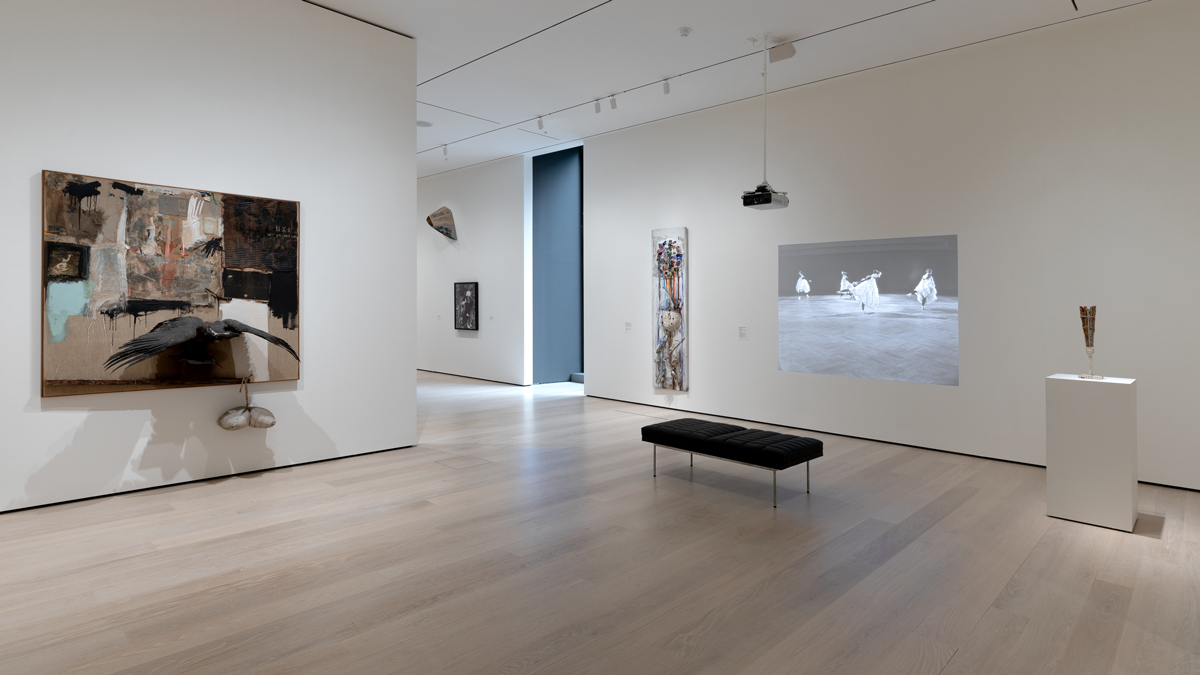
Installation view of the Museum of Modern Art’s reopening collection rehang, showing work by, from left, Robert Rauschenberg, Niki de Saint Phalle, Merce Cunningham, and Cy Twombly in a gallery titled “Stamp, Scavenge, Crush.”
ROBERT GERHARDT/©2019 THE MUSEUM OF MODERN ART
While the strategy may not always work gallery-to-gallery, the successes far exceed the failures. Several galleries stand out, including one on the fourth floor titled “Stamp, Scavenge, Crush” that explores the materiality of early Pop. Here masterworks by Robert Rauschenberg (Canyon, 1959) and Jasper Johns (Flag, 1954–55, and Target with Four Faces, 1955) share space with works by artists (Ruth Asawa, Romare Bearden, Lee Bontecou, Atsuko Tanaka, Katsuhiro Yamaguchi) not generally associated with the tendency—and indeed, the word “Pop” is never invoked in the gallery didactics.
Rather than privilege the icons, the installation is designed around two recent acquisitions: a hand-printed and stamped bedsheet by Asawa and a film documenting Merce Cunningham’s groundbreaking 1958 performance Antic Meet featuring a set and costumes designed by Rauschenberg. The de-centering of Johns and Rauschenberg effectively resets the playing field, creating space for alternative voices to register on their own terms and a platform for new scholarship around interdisciplinary exchange between artists at the time.
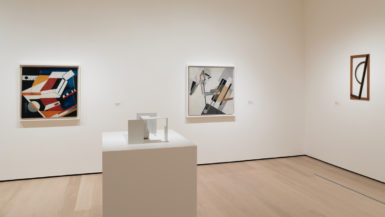
Installation view of the Museum of Modern Art’s reopening collection rehang, showing work by, from left, Alexandra Exter, Katarzyna Kobro, El Lissitzky, and Vasyl’ Iermilov in a gallery titled “Abstraction and Utopia.”
JONATHAN MUZIKAR/©2019 THE MUSEUM OF MODERN ART
A gallery titled “Abstraction and Utopia” on the fifth floor forefronts two commanding yet lesser-known figures of the early 20th-century Russian avant-garde: Liubov Popova and Alexandra Exter, whose Painterly Architecture (1917) and Construction (1922-23), respectively, anchor the main wall. This central placement allows for the sensibilities of the female painters to determine the room, which yields an unexpected selection of paintings in muted tonalities by Piet Mondrian, El Lissitsky, and Kazimir Malevich. Mondrian’s Composition in Color Planes 5 (1917) would likely not have made the cut in the past presentations of greatest hits, yet its presence is breathtaking in this context and suggests something new and profound about the Dutch artist’s range and versatility.
There are other examples of strategic placement that yields glorious space and appropriate context for female artists—among them Tarsila do Amaral, Dara Birnbaum, Gretchen Bender, Geta Brătescu, Mary Beth Edelson, Sonia Delaunay, Suzanne Duchamp, Eileen Gray, Maren Hassinger, Carmen Herrera, Hilma af Klint, Greta Lihotsky, Maria Martins, Lygia Pape, Kay Sage, Remedios Varos, Martha Rosler, Lotty Rosenfeld, and Florine Stettheimer. The assertion of the role of women at MoMA is one of the greatest achievements of the new rehang, a reality not possible without committed institutional focus on the addition of new purchases and gifts. There are entire galleries comprised of recent acquisitions, including a second-floor room titled “Hardware/Software” in which you will find major works by Maren Hassinger, Maria Lassnig, Senga Nengudi, and Joan Semmel acquired since 2010.
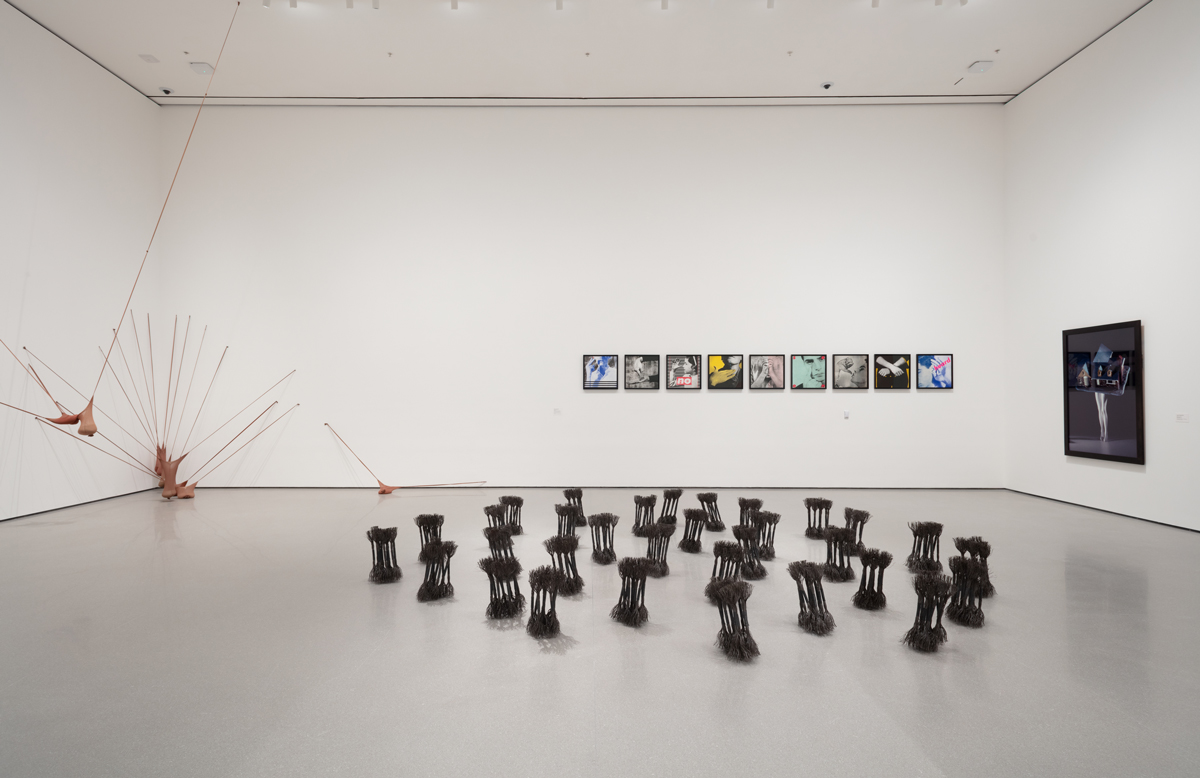
Installation view of the Museum of Modern Art’s reopening collection rehang, showing work by, from left on wall, Senga Nengudi, Barbara Kruger, and Laurie Simmons and, on floor, by Maren Hassinger, in a gallery titled “Hardware/Software.”
ROBERT GERHARDT/©2019 THE MUSEUM OF MODERN ART
Strategic collecting and re-positioning also determine how artists of color are integrated throughout the museum, with notable special exhibitions of pioneers Betye Saar and Pope.L as well as an ongoing partnership with the Studio Museum of Harlem. But the voices of indigenous and Latinx artists are virtually non-existent. The priority is, rather, on Latin America and the Southern Hemisphere rather than U.S.-based Latinos. Other than in focused presentations, the strategic insertion of these actors in a larger global context are nominal, especially for artists from Africa, Asia, and the Middle East. When they do appear, they tend to be concentrated, as in the gallery devoted to Chinese art after the 1989 uprising at Tiananmen Square.
At times such international assertions are illustrative, as on the sixth floor in “Surrounds: 11 Installations,” a series that resembles a global biennial presentation. But there are instances in which some inclusions appear to be tokenized, typically when there is a lack of strong representation within the collection. The Chilean artist and poet Cecilia Vicuña’s stunning Black Panther and Me (ii), 1978, for example, is asked to represent too many agendas: feminist, indigenous, Latin American, and international.
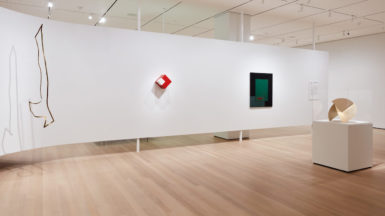
Installation view of “Sur moderno: Journeys of Abstraction―The Patricia Phelps de Cisneros Gift” at MoMA.
©2019THE MUSEUM OF MODERN ART/HEIDI BOHNENKAMP
While a focus on Latin American art is impressive in “Sur moderno: Journeys of Abstraction—The Patricia Phelps d Cisneros Gift,” a divine third-floor exhibition culling from a recent transformative donation of Latin-American abstraction, I long for the integration of this extraordinary work with the rest of MoMA’s holdings in future rehangs. And I want to see more installations of the caliber of the fourth-floor gallery titled “War Within, War Without,” where the integration of artists from Latin America is manifest boldly. I literally gasped when I stumbled upon Brazilian sculptor Maria Martins’s haunting intertwined bronze figures The Impossible, III (1946) flanked by Maya Deren’s groundbreaking film A Study in Choreography for Camera (1945), Wifredo Lam’s The Jungle (La Jungla), 1943, Louise Bourgeois’s Sleeping Figure (1980), and Sonja Sekula’s The Town of the Poor (1951). MoMA’s reimagination of the modern canon is most fully and robustly realized here in a brilliant and sophisticated choreography of artists across media, generations, and borders.
The “War Within, War Without” gallery demonstrates the best of what the new philosophy of presentation at MoMA has to offer, which is an incredible amount of curatorial license and freedom to experiment. The ability to create prototypical modules like this that can then be rejected or scaled inspires the necessary risk (and possible failure) required to make true structural change. The approach also allows for quirky and anomalous works by artists that are frequently left out of definitive collection presentations and retrospectives. Prime examples at MoMA now include Paul Gauguin’s Still Life with Three Puppies (1888), Eva Hesse’s Untitled (1960), Séraphine Louis’s Tree of Paradise (1928), František Kupka’s Mme Kupka among Verticals (1910-11), Henri Matisse’s The Rose Marble Table (1917), Janet Sobel’s Milky Way (1945), Wolf Vostell’s B52 Lipstick Bomber (1968), and Lawrence Weiner’s A 36” x 36” Removal of the Lathing or Support Wall of Plaster or Wallboard from a Wall (1968).
There is no question that the success of the experiments at MoMA is due in large measure to the depth and breadth of the collection, but it also acknowledges concerted efforts to grow and consciously diversify in targeted areas. In the fourth-floor gallery marked “In and Out of Paris,” masterworks by Latin-American artists Carmen Herrera and Lygia Pape from the ’50s are exquisitely paired with paintings by Ellsworth Kelly from the same moment. The presentation is a big improvement on a similar one uptown at the Met in “Epic Abstraction: Pollock to Herrera,” which pits a less significant work by Herrera from 2012 against a Kelly.
MoMA’s installation shows that you have to have the right stuff to dislodge and reorder the canon. But what is most exciting to see is the genuine and generative earnestness on the part of the curators and their devotion to humility, experimentation, and inquiry. While quality remains paramount, how it is defined remains open to shifting interpretation that can change with time. And it is a mindset cognizant of such change that marks the new MoMA as the first real attempt by a major museum to imagine an authentic and potentially lasting structural shift.
[ad_2]
Source link

